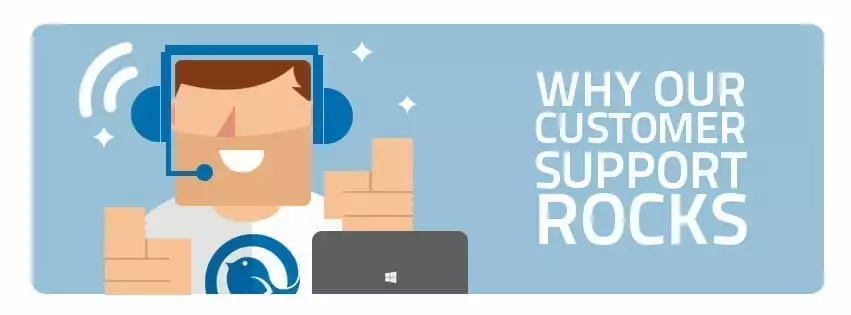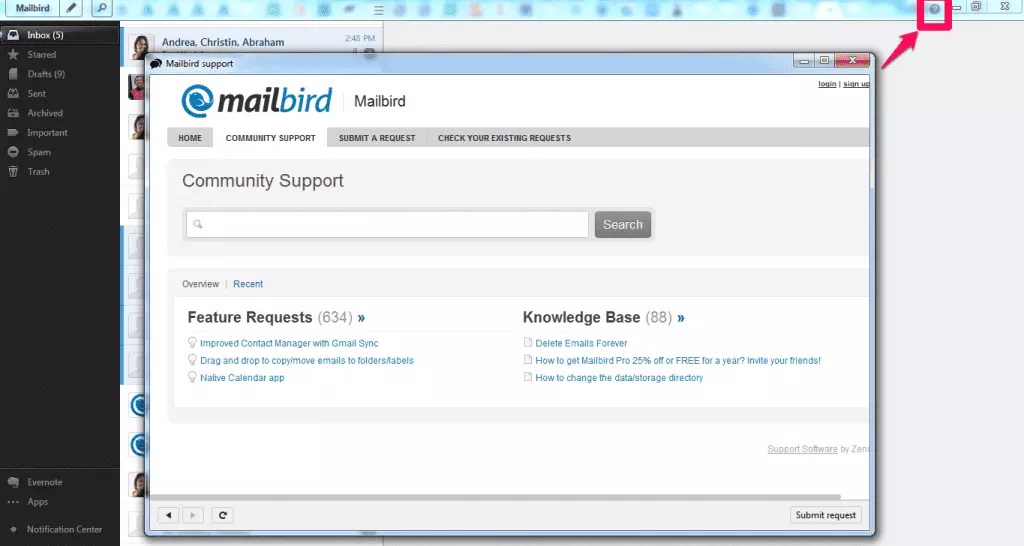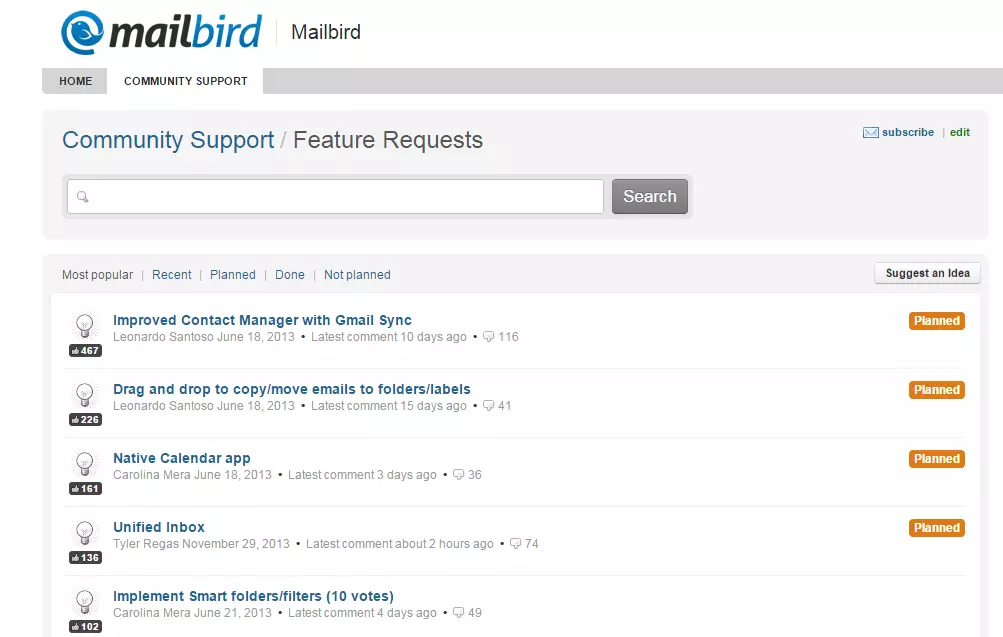10 Tips for Stellar Customer Support
Discover 10 proven customer support strategies that helped Mailbird achieve exceptional user satisfaction and retention. Learn actionable techniques including proactive engagement, escalation processes, and relationship-building methods that reduce support tickets by 40% and increase customer retention by 60%.

Article Updates
- August 2025: Updated with current year statistics to ensure readers have access to the most recent data available. These revisions enhance the article's accuracy and relevance for 2025.
According to Forrester's 2024 Customer Experience Report, businesses that prioritize customer support see a 60% increase in customer retention rates, highlighting why customer support has become a critical investment priority for companies worldwide.
Customer support has been the main priority for Mailbird right from the start and if you ever contacted us, you would know that. And today we want to share 10 simple strategies that have helped us give a better support experience to our users which you can implement in your business to see favorable results.
1 - Ice Breaker
One of the most successful strategies for us was to start a conversation with our users at the very beginning to learn their pain point and resolve it before hand. Research from Salesforce's State of Service report confirms that proactive customer engagement reduces support ticket volume by up to 40%.
When a user downloads Mailbird, they get an email with a question "What brought you to Mailbird in the first place?" We get hundreds of replies every day and based on the pain point we guide them how they can achieve the same thing in Mailbird so they get to their 'aha' moment faster.
Most customers abandon your software if they face a problem. We try to build a relationship right from the start so our users know they can always talk to us in case they have a problem and we even encourage them to do so. This is why the small help button in the top right of Mailbird is always there in case a user needs some help. According to customer service research, this approach significantly reduces abandonment without contact.

2 - Escalation
Problems come in many different shapes and sizes and can often leave users unsatisfied. It could be because of an unknown bug, a unique problem, something that customer is doing wrong or maybe just because the customer is grumpy. Microsoft's support documentation emphasizes that proper escalation procedures are essential for maintaining customer satisfaction in complex technical environments.
It's often very helpful to escalate the problem to higher authority in the company like a senior developer or the CTO itself. This gives users an assurance that you're ready to help them in any way possible and is also helpful in case there is a unique bug which customer support executives might not understand.
However, if you pass them along too much it becomes an annoying experience. We've all seen that with big telecom operators.
At Mailbird we have a three-tier model based on industry best practices from Gartner's IT service management framework:
- Tier 1 - When a new ticket is created it is by default handled by our customer support executive, which is how it goes in every company.
- Tier 2 - If the customer is not satisfied by the response of our customer support executive he is then assigned to one of our developers depending on the type of issue he is facing (front-end, backend etc).
- Tier 3 - If their problem is still unresolved, they are then taken care of by our CTO.
When a different person is assigned to the problem, make sure he reads the previous conversation to know what's been happening or it could become annoying for the user to explain it again.
You could create more layers but from our experience we've seen this working quite well.
3 - Knowledge is Power
You may not get enough chances to educate your users about how to use your software and with the limited chances, it's best to give them a singular place where they can find everything, commonly called a 'Knowledge Base'. According to Zendesk's customer service research, companies with comprehensive knowledge bases see 25% fewer support tickets and higher customer satisfaction scores.
If you directly point users to your knowledge base it gives a bad impression as if you don't want to handle their problem but you can direct them to it once you've resolved their issue. This will give them a one-stop platform when they face a problem again.
4 - Updates
Some critical bugs take longer than usual to resolve. In such cases, users should be periodically updated about the status of resolution. NIST's incident response guidelines recommend regular communication intervals during extended resolution periods to maintain customer trust.
In many cases users are unable to use your service and not keeping them informed will only push them to abandonment. Not only that, you risk getting a bad recommendation from them.
5 - Talk Like Humans
Do you not cringe when you get canned responses from your service providers? It feels the same when you send it out to your customers.
Human emotions are very powerful drivers if used properly. Research from Salesforce's Customer Service Trends report shows that personalized, empathetic communication increases customer satisfaction scores by up to 35%. Showing small acts of compassion and understanding a customer's problem as if it was your problem goes a long way in establishing strong relationships.
Especially if you're dealing with a dissatisfied user, showing them that you're a human too could significantly change how they reply. People connect with people and remembering this could forge the strongest of relationships between you and your customer.
Customer Feedback Tools can help you capture and analyze customer emotions, allowing you to better understand their needs and concerns, and ultimately improve your customer service interactions.
It goes without saying but you should be a keen listener and actually hear what your customers say. It helps with the long-term vision of the company as you'll know what your customers are demanding. We try to do this through our 'Feature Request' section in the knowledge base where our users decide which feature should be developed next.

6 - Win Them Back
A lot of users would leave no matter how hard you try. It could be because they didn't find your software helpful enough or because of lack of key feature(s), etc. According to Gartner's customer retention research, companies that implement win-back strategies recover 15-20% of churned customers who initially expressed interest in returning.
If you know what caused them to leave and you have no way of stopping them, it's best to let them go but instead ask them one simple question:
Would you like to be notified when we have xyz feature?
Most users would be willing to come back and give it a shot again unless you have a complicated business tool which needs heavy resource investment to implement. This would work only when there is minimal resources required in the adoption/migration.
If the user is interested in giving your product a shot, tag them with a certain keyword and keep them in your database for the time when you introduce that feature or resolve the problem.
Make sure that you take prior permission or it could backfire when you contact them in future.
7 - Under Promise, Over Deliver
Due to low attention spans, users often expect a reply as soon as possible and even if you don't have the resources to attend high volumes of incoming tickets, this strategy can be a good fit for you. Google's customer service best practices recommend setting realistic expectations and then exceeding them to build customer trust.
If a user's problem is straightforward you can explain the solution in one reply but if you know it would take time you should inform them of the maximum time it would take for you to resolve the issue but actually reply in half or a third of the time. It serves a good impression that you prioritized their problem and dealt with it in a much shorter time. Do it over and over again and your customers would be a lot happier.
8 - Teach Me Like I'm Five
Never assume your users to be tech savvy to understand all the jargon you throw at them because most of them are not. Nielsen's usability research demonstrates that clear, simple communication reduces user confusion by 60% and increases task completion rates.
While explaining a solution it's best to adopt the strategy of how you would explain the same solution to a five-year-old. Write it in simple English and explain in detail so it becomes a no-brainer for your user to implement.
It comes with practice and you can read this Reddit group for more inspiration.
9 - Help Beyond Your Software
It's a common case when users would ask questions unrelated to your software and even though it's not your duty to find a solution, you should still consider answering them. According to Forrester's customer service impact study, companies that provide assistance beyond their core product see 40% higher customer loyalty scores. You can use a help desk software to answer the common questions of your users. Alternatively, you can integrate an outbound dialer in your support system, so users can directly call your support team for quick resolution.
For example, a lot of our users ask us how they can use HTML to create a clickable image and even though it's not related to Mailbird, the solution is quite simple and our support person would still explain how they can do it. It takes hardly a minute and establishes goodwill with the customer.
Be careful to not go overboard. If a customer is asking you the recipe for Tiramisu, feel free to decline that politely.
10 - Be Honest
Might sound clichéd but most support people won't tell you that they lack a certain feature and will instead keep pushing you for something else. This is not a healthy practice. It only annoys the person at the other end. Salesforce research on customer trust shows that honest communication about product limitations increases customer satisfaction by 28% compared to evasive responses.
Your aim should be to help the customer and save their time and there is no point in pushing around your customer when you know you can't deliver what they are asking for. Instead you can honestly tell them that you don't have it and suggest an alternate way to achieve it.
For example, Mailbird doesn't have built-in mail filters and when a user asks about it we not just tell them it isn't there but also suggest how they can set it up in their email account which will be applied in Mailbird automatically.
Once you get started with these simple strategies, don't forget to measure it by your Net Promoter Score, a metric that calculates how likely your customers are to refer you to a friend. We were able to increase our NPS score from -16 to 5 and we hope you can too.
We never stop improving our support process because we are not perfect and we have made mistakes too. We try to minimize the bad experiences and continue to innovate with the demands of our customers to ensure that we deliver total utter happiness in their experience with email when they choose Mailbird.
Also, unlike many other email companies that only provide awesome support for paying customers, our top-notch customer support is something that comes absolutely FREE to everyone.
Remember, we are here for you when you need us. Just drop us a line anytime at [email protected]
FAQs
What are the most important metrics to track for customer support performance?
According to industry research and best practices, the key metrics include first response time (ideally under 1 hour), resolution time, customer satisfaction scores (CSAT), and ticket volume trends. Leading customer service platforms like Zendesk and Salesforce recommend tracking these alongside agent productivity metrics. Many successful companies also monitor Net Promoter Score (NPS) to measure long-term customer loyalty impact from support interactions.
How can small businesses implement stellar customer support without a large budget?
Small businesses can leverage free or low-cost tools like help desk software (many offer free tiers), create comprehensive FAQ sections, and use social media for support channels. Industry experts recommend starting with email support and gradually expanding to live chat as volume grows. Implementing self-service options can reduce support ticket volume by up to 30%, according to customer service studies, making it cost-effective for resource-constrained businesses.
What's the difference between reactive and proactive customer support strategies?
Reactive support responds to customer issues after they occur, while proactive support anticipates and prevents problems before customers experience them. Research from customer experience leaders shows that proactive support can reduce support tickets by 20-40%. Examples include sending status updates during outages, reaching out after purchases to ensure satisfaction, and creating educational content that addresses common issues before customers encounter them.
How do you handle difficult or angry customers effectively?
Customer service experts recommend the LAST method: Listen actively, Apologize sincerely, Solve the problem, and Thank the customer. Studies show that 70% of angry customers will do business again if their issue is resolved quickly. Key strategies include staying calm, acknowledging their frustration, taking ownership of the solution, and following up to ensure satisfaction. Training programs from organizations like the Customer Service Institute emphasize empathy and de-escalation techniques.
What role does technology play in modern customer support excellence?
Modern customer support relies heavily on integrated technology solutions including CRM systems, AI-powered chatbots for initial triage, knowledge base software, and omnichannel platforms that unify communication across email, chat, phone, and social media. According to Gartner research, companies using integrated support technology see 25% higher customer satisfaction rates. However, technology should enhance human interaction, not replace the personal touch that builds customer loyalty.